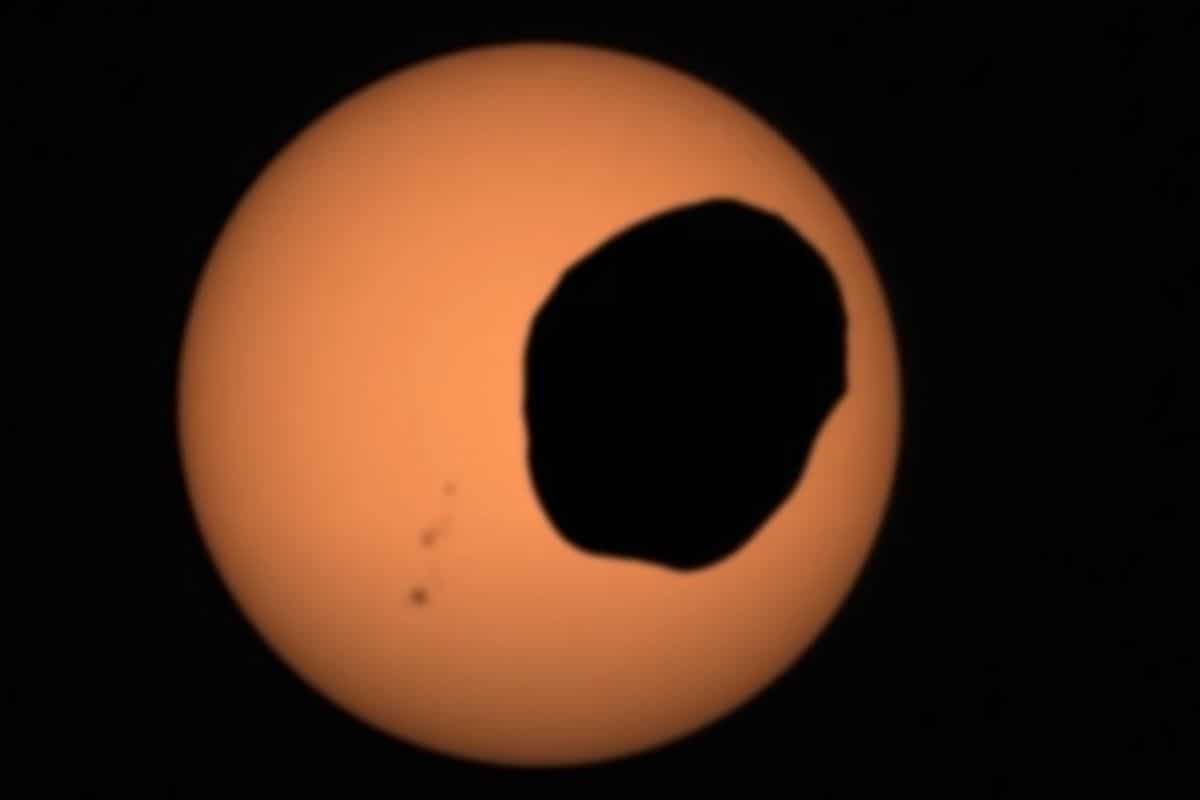The Perseverance Mars probe earlier this month witnessed that one of Mars’ moons – Phobos – has passed in front of the sun. This produces amazing pictures!
Solar eclipses are always big news here on Earth. It is no different on Mars. So, the Persevering Mars rover was ready for it at the beginning of this month and recorded the complete eclipse – which, incidentally, lasted just over 40 seconds.
solar eclipse
When a solar eclipse on Earth is caused by the moon crawling in front of the sun and blocking (a portion of) the sun’s light, it’s actually no different on Mars. Only there is not our moon, but one of the two moons of Mars moving in front of the sun. At the beginning of April, it was Phobos’ turn: the largest moon on Mars.
private pictures
It’s certainly not the first time a rover on Mars has captured a solar eclipse caused by Phobos. In 2004, based on images taken by the Mars rover Spirit and Opportunity, a interval from a solar eclipse. Years later, the Curiosity spacecraft photographed a solar eclipse. However, the images presented by Perseverance are now distinctive. The Mars rover used Mastcam-Z for this purpose, which is a camera that can be zoomed in – unlike Curiosity, which also has a Mastcam. And that’s what Perseverance did while capturing the eclipse. It results in our most magnified image of the solar eclipse caused by Phobos. In addition, the frame rate – The number of photos taken by the camera per second – much higher. What also makes the images special is that they are colorful. “It’s great to see the eclipse as the Mars rover observed it,” said researcher Mark Lemon.
“I knew it (Pictures, Editor) was going to be good, but I didn’t expect it to be this great,” said Rachel Howson, who is part of the team responsible for managing Perseverances Mastcam-Z. And this is no exaggeration, see for yourself below!
What is immediately noticeable is that Phobos’ shadow – despite the bright sunlight – has been captured in detail through perseverance. This is thanks to the fact that Perseverance’s Mastcam-Z is fitted with a solar filter that actually acts as a kind of sunglasses. “You can see the details in the form of Phobos’ shadow, like ridges and ridges on the moon,” Lemon said. Details can also be seen on the sun itself. “You can also see sunspots.”
The images are not only amazing, but also useful. This allows researchers to use the observations to get a better picture of Phobos’ orbit. In addition, researchers hope to learn more about Mars through Phobos. As Phobos orbits Mars, it exerts its own gravity on Mars. The rocks in the crust and mantle are slightly deformed. By studying the changes Phobos makes on Mars through this gravitational influence, scientists can also better understand how flexible that crust and mantle are and draw conclusions about their formation based on that.
About Phobos
Phobos is a potato-shaped moon orbiting Mars. It’s not the only moon rich in Mars: Deimos also moves around Mars. Phobos is the largest moon on Mars. However, Phobos is about 22 kilometers in diameter, and is still 157 times smaller than our moon. Phobos is much closer to Mars than the Moon is to Earth; The distance between Mars and Phobos is about 6000 km, while the Moon is more than 384,000 km from the surface of the Earth. The distance between Phobos and Mars is also getting smaller and smaller. Phobos is expected to explode even on Mars in a few tens of millions of years.

“Lifelong zombie fanatic. Hardcore web practitioner. Thinker. Music expert. Unapologetic pop culture scholar.”








